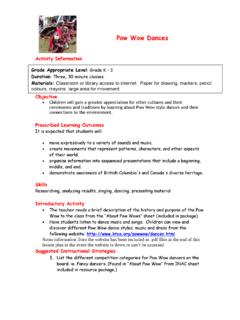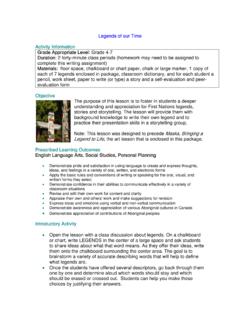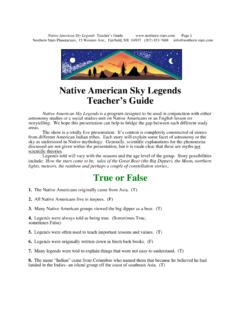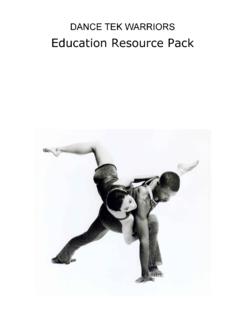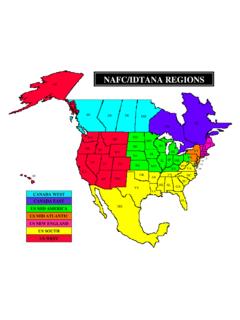Transcription of POW WOW Dance final - landscapesmag.com
1 pow wow Dances Activity Information Grade Appropriate Level: Grade K - 3. Duration: Three, 30 minute classes. Materials: Classroom or library access to internet. Paper for drawing, markers, pencil colours, crayons, large area for movement. Objective Children will gain a greater appreciation for other cultures and their ceremonies and traditions by learning about pow wow style dances and their connections to the environment. Prescribed Learning Outcomes It is expected that students will: move expressively to a variety of sounds and music. create movements that represent patterns, characters, and other aspects of their world. organize information into sequenced presentations that include a beginning, middle, and end. demonstrate awareness of British Columbia's and Canada's diverse heritage. Skills Researching, analyzing results, singing, dancing, presenting material Introductory Activity The teacher reads a brief description of the history and purpose of the pow wow to the class from the About Pow Wows sheet (included in package).
2 Have students listen to Dance music and songs. Children can view and discover different pow wow Dance styles, music and dress from the following website: Some information from the website has been included as .pdf files at the end of this lesson plan in the event the website is down or can't be accessed. Suggested Instructional Strategies 1. List the different competition categories for pow wow dancers on the board. ie. Fancy dancers. (Found in About pow wow from INAC sheet included in resource package.). 2. Dancers wear regalia with fringes of yarn or fabric on their aprons, capes, and leggings. Have children illustrate a Dance outfit. They may also be encouraged to study how the Dance outfits were made and dyed with tree barks and leaves. Some information about native plant dyes is included as .pdf files if the information on the website above can't be accessed. 3. In a large open space, gym or outdoors, encourage children to stomp their feet in a way that looks like they are flattening out grass on a field, as danced in the Men's Grass Dance .
3 4. Demonstrate by moving arms in a smooth, fluid motion, how the fringe on a dancers' outfit can look like grass swaying. Have children join in by moving arms like swaying grass. During some pow-wow dances, First Nations say they are making spiritual connections to the trees, rivers, grass and animals given by the Great Creator. Suggested Assessment Strategies Students will present and describe their illustrations and research of aboriginal dancers and clothing to the class. Teacher will ask for the reason behind their Dance selection. Extension Activity Ideas Invite a First Nations community member to present Dance clothing and music to the class. Attend a pow wow with students as a field trip. Cross-Curricular Interests Geography, History / Social Studies, Language Arts, Fine Arts, Technology Suggested Links - pow wow terminology ~matink/themes/ #CUL. (Leaves, Fruit, Trees, Spiritual Messages of the pow wow ).
4 Lesson plan provided by: Fored BC. Developed by: Audrey Perun, Education Services Coordinator Additional pow wow Background, excerpted from pow wow is derived from the Algonquian word pau wau . It means, He dreams . Although today's pow wow retains some religious significance, this isn't as pervasive as it was in earlier times. The white man perceived Indian dancing as a threat until the late 1800's and early 1900's, particularly those performed by the fierce Plains Indians. They saw all Indian dances as war dances and prohibited them. The re-emergence of the pow wow was related to the ceremonies instituted on reservations to honour the veterans returning home from the wars engaged in by the United States. These ceremonies were revitalized. Tribes joined together for the first time in this new pride. This led to intertribal Pow wows in which dances, songs, and other observances were shared. Today the many different types of Pow wows held throughout the country also include selling or trading arts and crafts, and feasting on traditional Native American foods.
5 Dance , however, remains the highlight of the pow wow . Today dances include Round Dances or Circle Dances, performed by facing the center of the pow wow arena in a circle. Dancers circle left with various styles of footwork while keeping time with the drum. Straight Dance is one of the oldest forms of Plains Indian Dance , and involves straight posture while dancers primarily move up and down in fluid motion to the beat of the drum. The slide or shuffle Dance is done to a double beat. Sometimes it is changed to a staggered beat and referred to as the Crow Hop, done by hopping to noticeably solid beats. Solider Dances were developed after world war I to honour Veterans. The beat is similar to the Round Dance , but is slower as time is kept to every other beat. The Stomp Dance begins in a kneeling position as if scouting for an enemy, followed by a burst of Dance . Dancers move forward to symbolize none retreating.
6 The Grass Dance is one of the oldest dances and is still used in pow wow . Religious in nature, it evolved from warrior society dances. It portrays a warrior in search of a proper ceremonial place. The dancer moves in imitation of tall swaying prairie grass. Dreams or visions were the basis of the Jingle Dress Dance . The dress for this Dance is fashioned with such items as small hawk bells, shells, or sewing thimbles to give it sound. The Dance was originally used as medicine. Movements have undergone several transitions, and today's dancers twist their feet in unison to the right and left while moving sideways. The Fancy Shawl Dance , one of the most popular dances with women today, originated with middle aged tribal women, and eventually spread to younger women. As it evolved, shawls were added. Today, the body and shawl are kept in harmony with the drum beat. These and other dances can be seen at the hundreds of pow wow held throughout the country.
7 The pow wow is a living cultural expression of song, Dance , and art which brings people together, and through the drum, reminds us of our connection to Mother Earth. There are also two types of pow wows; the traditional pow wow , where everyone who participates receives something through a give away or gifts or money from the sponsor of the top two or three dancers in each category. These competition pow wows attract singers and cancers from many places and is, in fact, a way of life for many people during the summer time. Pow wows are a time to put differences aside and to celebrate traditions; mostly it is the time to celebrate life. A pow wow strengthens an entire race of people. To be Anishinabe is to be proud; to know who you are, and where you came from. Additional Background sheets to follow include: -Cedar dye info for pow wow Dance - Native american plants used for dyeing - pow wow Men's traditional Dance - Men's grass Dance - Women's traditional Dance RED CEDAR - NativeTech: Indigenous Plants & Native Uses in the Northeast Page 1 of 1.
8 NativeTech: Native American Technology and Art Indigenous Plants & Native Uses in the Northeast RED CEDAR. (Juniperus virginiana). Medicine: Twigs boiled together and sprinkled on hot stones (or brewed into tea) for Rheumatism. In ceremony a sacred wood, known as a medicine tree. Native Americans say the tree was blood-stained by an wicked magician. The wood is burned only for ceremony, and the smoke is believed to drive away negative influence. Technology: Inner bark strips are pealed from the tree. Strips may be split into fine lacings and ties. Cedar strips were also used to weave storage bags and finely twined mats. Cedar strips also make a red dye. Cedar wood was splint into planks for use in lining birch bark canoes. Chippewa used cedar bows for bedding material. <<- ->>. Previous Next Plant Plant Return to Plants Gathered in the Northeast Return to Gathering Walk Plant Bibliography and Books to Order On-line Explore other areas of Text and Graphics 1994 - 2004 Tara Prindle unless otherwise cited.
9 6/4/2004. Western Red Cedar - Natural Dye Plants Page 1 of 2. Western Red Cedar - Dye Plants Thuja plicata Related Resources The Western Red Cedar - Thuja plicata, is British Columbia's provincial Natural Dyeing tree. It grows to heights of over 50 metres tall. The bark is grey to reddish Information brown and has an aromatic wood, with glossy yellow/green leaves. Natural Dye Plants References Bookstore Most tree barks will produce some type of dye, due to the tannins that are in the bark. To extract the dye does take some time as the bark needs to soak in water for a day or two, prior to dyeing. I am fortunate to have several large red cedar trees on our property. I pulled a few strips of bark from each tree and chopped them into small pieces. I soaked the bark chips in water overnight. If you don't have red cedars growing in your back yard, try obtaining some cedar bark mulch (that hasn't been leached) from a gardening shop.
10 The following day I filled a dyepot with hot water and put the bark mixture into the dyepot. I let the dye mixture simmer for a few hours on low heat. Then I put clean fleece that had been processed in an Alum mordant, into the dyepot. I let the mixture simmer for about 2-3 hours, on low heat. The wool only had a hint of colour in it. So I then let it simmer for another few hours. It was a bit darker by then. I turned off the heat, and left the mixture to sit overnight in the dyepot. The next morning, the wool had dyed to a pleasing, soft shade of honey. Pictures Some more pictures of my dye project. How to Dye with Red Cedar Bark A recipe using Red Cedar bark to dye wool. Ecological Impact of Cedar The Western Red Cedar acts as an anchor for other trees and plants, securing them in the soil and providing shade and a wind break. They provide shelter for birds and smaller animals throughout the year, protecting them against rain and snow.
